An introduction programme for drivers of heavy motor vehicles
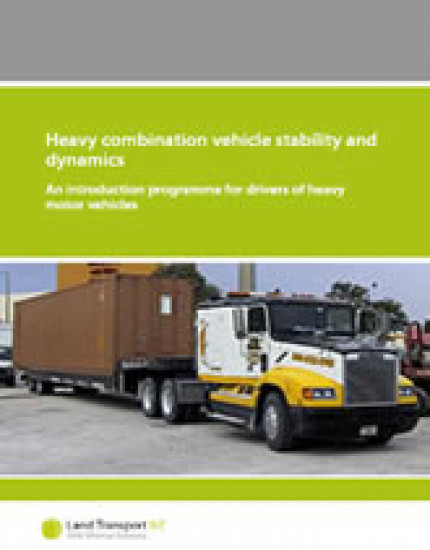
Like everything around us, we are all affected by the laws of nature. These laws ensure that:
These same principles apply to our vehicles and, while they cannot be totally eliminated, they can be controlled and their effects minimised.
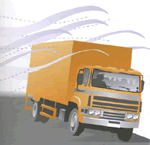
Vehicles with high flat sides, such as furniture trucks and trucks transporting containers, are extremely susceptible to the effects of cross wind (wind blowing onto the side of the vehicle).
In conditions of extreme crosswind, road controlling authorities may issue strong wind warnings for some stretches of road. When these are issued take note and, if the warning includes advice not to travel over a particular area of road - don't.
Remember also that your vehicle will generate its own wind as it moves along the road. The faster you go, the greater the wind forces generated will be. These forces can be sufficient to blow motorcyclists over and buffet other vehicles to a point that the driver loses control, so you need to be considerate of other road users and slow down.
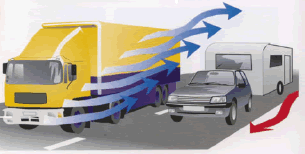
The effect of speed on the cornering ability, braking distance and impact forces acting on a vehicle increase as the speed increases. Cornering forces don't just double when the vehicle speed doubles, they increase by four times.
This effect is highlighted in the following diagram.
The arrow in the left-most illustration represents the overturning force acting on a truck in a 30 kilometre per hour (km/h) corner. If the same truck is driven through the same corner at 60 km/h, the overturning forces will be four times higher (2 x 2 = 4, speed-squared effect), represented by the arrow in the middle illustration. If the truck is now driven through the corner at 90 km/h the overturning forces will be nine times higher (3 x 3 = 9, speed-squared effect) than at 30 km/h, as in the third illustration.
This speed-squared effect has a dramatic impact on the vehicle and its controllability.
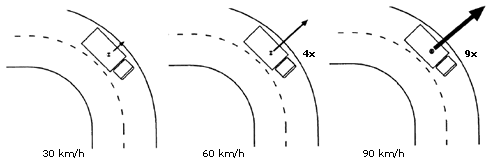
Gravity creates a force that, in simple terms, attracts everything towards the centre of the earth.
This force is measured as weight and means that a person weighing 90 kilograms (kg) and a truck weighing 15,000 kg are both attracted towards the centre of the earth with the same speed of acceleration. If both were free to fall they would accelerate at the same rate, called one gravity (1 g).
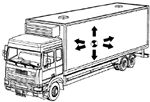
Every object affected by gravity has a centre of gravity (CG), which is the point around which the object, if placed on a pointed stick in the ground, would be balanced in all directions. The higher the CG, the more unstable the object (such as a truck) will be. The closer to the ground, the more stable the object.
Thus the stability of a truck is largely dependant on the height of its CG above the ground. If a load is not centred across its width; the stability will be reduced when cornering.
If the load is not balanced correctly along its length, wheel lock-up during braking becomes a distinct possibility. When wheel lock-up occurs, the vehicle loses steering control.
Kinetic energy is the energy present in any moving object. The heavier and/or faster the object, the more energy it will contain.
A bullet, for example, is small but extremely fast and has the potential to do a lot of damage over a small area owing to its kinetic energy. A truck, on the other hand, is relatively slow but is extremely heavy and has the potential to do a great deal of damage over a greater area for the same reason.
While a bullet's energy is either absorbed by the target or eventually eliminated by friction as it moves through the air, the energy in a vehicle is converted to heat by the friction that occurs in the brakes when the driver applies the brakes.
The effects of kinetic energy increase at the square of the speed - and have a major influence on all motor vehicles in three particular situations, as explained below.
1 Braking
The faster a vehicle goes, the further it takes to stop.
As the table below shows, if a truck's speed is doubled it will take at least four times the distance to stop. Longer if the road is wet.
| Truck speed | Weight | Road surface | Stopping distance |
|---|---|---|---|
| 35 km/h | 38,000 kg | Dry | 9 metres |
| 70 km/h | 38,000 kg | Dry | 37 metres |
| 70 km/h | 38,000 kg | Wet | 72 metres |
2 Cornering
If a truck enters a corner at 60 km/h, there will be four times more overturning (side) force on the vehicle than if it had entered the corner at 30 km/h.
3 Impact
The damage to a vehicle (and its driver) at the point of impact in a crash situation will also increase in proportion to the square of the speed. In other words, double the speed = four times the damage, triple the speed = nine times the damage. A pedestrian knocked down at 60 km/h will most likely suffer four times as much damage as one knocked down at 30 km/h.
Friction is the resistance to motion that occurs when one body or surface moves across another. On a vehicle the most common points of friction are the brakes, the tyre contact with the road, air resistance, and engine and transmission components. It is the friction between the tyres and the road that allows the driving, braking and cornering forces to be transmitted to the road surface.
Friction creates heat. Vehicle braking systems produce large amounts of heat, which has to be dispersed very quickly. The secret to a good braking system its ability to remove that heat quickly and efficiently.
The faster a vehicle is travelling, or the heavier it is, the more heat the brakes generate in bringing the vehicle to a stop.
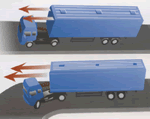
Centrifugal force occurs when a moving object, such as a vehicle, changes direction. This is the same force that causes passengers to slide across the seat and loose freight to slide across a deck when cornering at higher speeds.
The weight of a vehicle means that when it is travelling in a straight line it will try to continue in that direction, even when the driver turns the steering wheel.
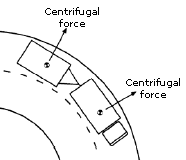
Changing direction causes the vehicle's weight to move to the outside of the turn which, unless the driver controls its speed, can lead to the vehicle rolling over or sliding out.
Centrifugal force is affected by the vehicle speed and the angle of turn. In other words, the faster the vehicle is going and/or the tighter the turn, the more likely the driver is to lose control of the vehicle and for it to roll over.